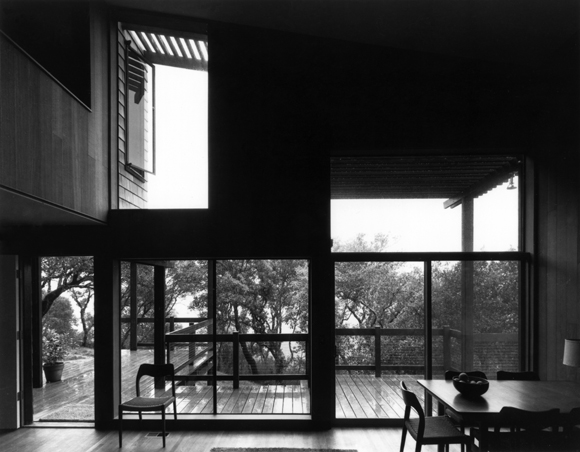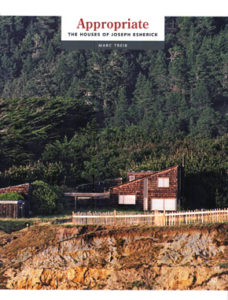
In his lifetime, the San Francisco architect Joseph Esherick (1914-1998) won the highest honors of the profession for design, education, and collaborative practice. Yet he has a less secure place in the US architectural pantheon than peers—Philip Johnson comes to mind—who practiced in the east and had closer ties to its media and cultural institutions. Ten years after his death, he finally has a monograph, one of a series that Marc Treib and William Stout are producing from UC Berkeley’s CED Archive. The book focuses on his houses—an important part of his legacy, but not the whole story. His firm, EHDD, did its own book earlier in this decade, but it omitted the older, larger work. A real monograph, perhaps a “Part Two” from Treib and Stout, would provide a fuller picture.

Coming from Philadelphia, Esherick brought an outsider’s view of the Bay Region. In this respect, he is like Edward Charles Bassett, the SOM design partner who moved here from Michigan after working with Eero Saarinen, and Stanley Saitowitz, who came from South Africa, where he designed a series of provocative veldt houses. Each of them embraced the new region. Whether intentionally or not, they also redefined its architecture.
Esherick categorized his work according to what he was exploring. His explorations start with “packing the box” and also take in gables, pavilions, and light boxes. Treib uses this exploration as the book’s organizing device, not least because Esherick referred to it in his oral history. (He also summarized these explorations in an article in Space & Society in 1983.)
Esherick made a fetish of the “ordinary,” but it was very much a bespoke ordinariness, as practiced by the leisure classes. Treib’s “appropriate” better captures what the houses are about. They address terroir—the total nature of a place. The country houses especially are set in its midst, responding to everything around them. It’s as if he understood that everything unfolds—the people who live there, the rooms they inhabit, and the nature of the place itself. The houses, in Stewart Brand’s phrase, beat to the clock of the long now.
Architecture that mediates
While the hedgerow houses at The Sea Ranch are probably the best known and most iconic of Esherick’s residential projects, the Cary House for me best captures what his houses are about. The book permits a comparison between the remarkably open house designed by Esherick’s first wife, Rebecca Wood, and the sense of openness that the Cary House achieves while remaining enclosed. Like an Eichler, Wood’s glass window wall is entirely transparent. Esherick’s equivalent wall frames the views. This was Wurster’s influence, EHDD’s Chuck Davis told me, but Esherick’s walls are more aesthetically composed. The Cary House’s view-facing wall is a masterpiece of how to mediate between the human scale of dwelling and the inhuman scale of nature (as Wallace Stegner called it).
The Sea Ranch hedgerow houses take their formal cues from trees along the coast that bend in a Taoist manner to forces beyond their control, as well as from old sheds and barns whose shape and longevity reflect a similar strategy. The later, larger-scale work of Esherick’s firm also evolved by contending with difficult natural sites, like Monterey Bay and Utah’s Wasatch Range. The aquarium and the lodges at Deer Valley are pitched up against nature, and they unhesitatingly look around for successful precedents. Esherick was doing this in Tahoe in the late 1940s—houses that still resonate, not least because they have a foothold in the past. The Goldman House in San Francisco, which draws on the city’s Victorians, is an urban example of Esherick’s sympathy for known starting points, assuming (like the philosopher Friedrich Hayek) that tradition is the accrued wisdom of a people and a place. It’s in this sense only that Esherick’s work can be said to be ordinary.
Esherick and his collaborators
One virtue of the book is Treib’s careful crediting of Esherick’s collaborators. Almost all of his work was done with others. His partners Homsey and Davis established their own identities as design architects. (Peter Dodge’s role was more to shape the growing firm of EHDD.) Homsey, who de serves his own monograph, draws on the region’s deeper traditions, unafraid to tap those roots. He’s been compared to Aldo Rossi. If Charles Moore dabbled in this terri tory, Homsey really did something with it. Davis, enamored of technical challenges, pioneered a new generation of aquariums that solved the huge problems of the earlier ones and redefined people’s expectations of what an aquarium is and does. They both took EHDD in new directions.
The Bay Region is fortunate to have the CED Archive, a repository of drawings that complements the Bancroft Library’s collections of architects’ and critics’ papers and of the negatives of some of the region’s best architectural photographers. The books that Treib and Stout have generated from this trove, along with others like Pierluigi Serraino’s NorCalMod, are giving a new generation of architects, students, and enthusiasts a clearer sense of what the post-war generation wrought. Esherick is just one piece of that puzzle, but he’s an important piece. This monograph does justice to an architect who—despite his Gold Medal—never really made the canon. It’s a good book, and well deserved.
Appropriate: The Houses of Joseph Esherick, by Marc Treib, William Stout Publishers, 2008, reviewed by John Parman, who writes for AIA San Francisco’s LINE and The Architect’s Newspaper.
Originally published 4th quarter 2008, in arcCA 08.4, “Interiors + Architecture.”






